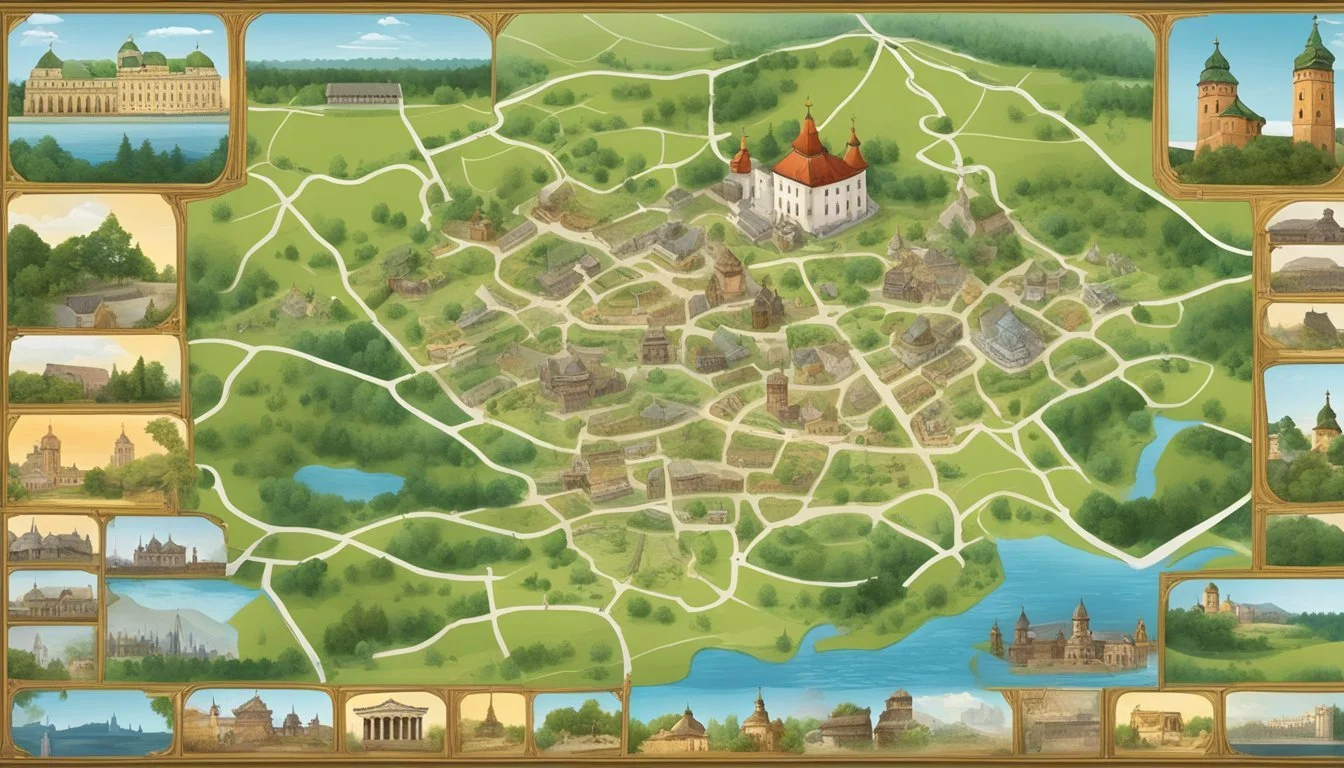7 Captivating Documentaries on Belarus
Unveiling the Heart of Eastern Europe
Belarus, a country often dubbed "Europe's last dictatorship," has been the subject of several compelling documentaries in recent years. These films shed light on the nation's complex political landscape, human rights issues, and the resilience of its people in the face of authoritarianism.
Documentaries about Belarus offer viewers a rare glimpse into the country's struggle for democracy and the everyday lives of its citizens. From underground theater groups to mass protests, these films capture pivotal moments in Belarus's recent history. They provide valuable insights into the challenges faced by those seeking change in a nation that has long resisted democratic reforms.
1) The Belarusian Waltz
"The Belarusian Waltz" is a thought-provoking documentary that sheds light on political dissent in Belarus. The film focuses on Alexander Pushkin, a performance artist who uses public stunts to challenge the authoritarian regime of President Alexander Lukashenko.
Directed by Andrzej Fidyk, this 2007 documentary offers a unique perspective on life under Belarus's repressive government. Pushkin's bold and often comical acts of protest serve as a central theme, highlighting the risks faced by those who dare to criticize the government.
The film explores the complex political landscape of Belarus, often referred to as "Europe's last dictatorship." It depicts a country where opposition voices are silenced, press freedom is limited, and dissidents face the threat of imprisonment and torture.
Through Pushkin's story, viewers gain insight into the resilience of the Belarusian people. The documentary captures the tension between the desire for freedom of expression and the harsh realities of living under an oppressive regime.
"The Belarusian Waltz" provides a window into the soul of Belarus, showcasing the power of art and individual courage in the face of totalitarian rule. It stands as a testament to the human spirit's capacity to resist oppression through creativity and determination.
2) The Crossroads of Europe: Belarus
Belarus occupies a unique position as a crossroads between Eastern and Western Europe. This documentary explores the country's pivotal role in the region's geopolitics and cultural exchange.
The film examines Belarus's historical significance as a transit route for trade and ideas. It highlights how various empires and powers have vied for control over this strategically located territory throughout the centuries.
Viewers gain insight into the modern-day implications of Belarus's position between the European Union and Russia. The documentary analyzes how this geographical reality shapes the nation's political landscape and international relations.
Interviews with experts and locals provide diverse perspectives on Belarus's identity as a "bridge" between East and West. The film showcases how this status influences daily life, from language use to economic ties.
Through stunning visuals, the documentary captures Belarus's blend of architectural styles and cultural influences. It illustrates how the country's crossroads status is reflected in its cities, countryside, and people.
3) A Lesson of Belarusian
This 2006 documentary by Polish director Mirosław Dembiński offers a glimpse into Belarus's political landscape. It focuses on pro-democracy youth activists in the weeks leading up to Alexander Lukashenko's controversial re-election in March 2006.
The film centers on students from the Belarusian Humanities Lyceum, an institution established to promote Belarusian language and culture. Despite being banned by Lukashenko's government, the school continued to operate underground.
Franek Viacorka, a student at the Lyceum, emerges as a key figure in the documentary. The film follows his and other young activists' efforts to challenge the authoritarian regime and advocate for democratic change.
A Lesson of Belarusian sheds light on the struggles faced by those opposing Lukashenko's rule. It portrays the determination of young Belarusians who refuse to give up their vision of a free and democratic country.
The documentary has garnered international recognition, winning multiple festival prizes. It provides viewers with a raw and intimate look at political activism in what is often called "Europe's last dictatorship."
4) The Babushkas of Chernobyl
"The Babushkas of Chernobyl" is a compelling documentary directed by Holly Morris and Anne Bogart. Released in 2015, it sheds light on a group of elderly women who returned to live in the Chernobyl Exclusion Zone after the 1986 nuclear disaster.
The film explores the lives of these resilient women who chose to return to their homes despite the radioactive contamination. They cultivate gardens, raise livestock, and maintain their traditional way of life in an area deemed uninhabitable by authorities.
Morris and Bogart's documentary offers a unique perspective on the aftermath of the Chernobyl disaster. It showcases the strength and determination of these women who preferred the risks of radiation to the emotional toll of leaving their ancestral lands.
The film provides insight into the daily routines of these "babushkas" (grandmothers) as they navigate life in a toxic environment. It captures their spirit and attachment to their homes, despite the potential health hazards.
"The Babushkas of Chernobyl" received critical acclaim for its portrayal of human resilience in the face of environmental catastrophe. It offers a thought-provoking look at the long-term consequences of nuclear disasters and the complex choices individuals make in their wake.
5) Belarus: An Undiscovered Treasure
Belarus remains an enigmatic destination for many travelers. This documentary sheds light on the country's hidden gems and rich cultural heritage.
Viewers are taken on a journey through Belarus's pristine countryside, showcasing its lush forests and serene lakes. The film highlights the nation's well-preserved natural landscapes, including the ancient Belovezhskaya Pushcha National Park.
Belarus's historical sites take center stage in this exploration. From medieval castles to Soviet-era monuments, the documentary presents a comprehensive view of the country's architectural treasures.
The film also spotlights Belarus's vibrant folk traditions and customs. It captures colorful festivals, traditional crafts, and local cuisine, offering a glimpse into the nation's cultural soul.
Urban centers like Minsk are featured, revealing a blend of historical charm and modern development. The documentary showcases the capital's wide boulevards, grand squares, and unique architectural styles.
Through stunning visuals and informative narration, this documentary invites viewers to discover Belarus's lesser-known attractions. It presents the country as a destination ripe for exploration, challenging preconceptions and inspiring curiosity about this Eastern European nation.
6) Man of Marble and Velvet: The Story of Belarusian Cinema
Belarusian cinema has a rich history that reflects the country's complex cultural and political landscape. The industry has produced notable works that explore themes of identity, resistance, and social change.
One influential film is "Man of Marble," directed by Andrzej Wajda. While not a Belarusian production, this Polish film resonates with Belarusian audiences due to its examination of propaganda and censorship under communist rule.
Belarusian directors have also made significant contributions to the country's cinematic legacy. They often focus on capturing the realities of everyday life and the psychological state of the nation.
Recent documentaries have gained international attention by offering unique perspectives on Belarusian society. These films use innovative techniques to present narratives that might otherwise be suppressed.
The Belarusian film industry faces challenges, including limited funding and political constraints. Despite these obstacles, filmmakers continue to produce thought-provoking works that contribute to the global cinematic conversation.
Festivals and international collaborations have played a crucial role in promoting Belarusian cinema. These events provide platforms for directors to showcase their work and engage with audiences worldwide.
7) Belarus Through the Eyes of Foreigners
Foreign filmmakers have contributed unique perspectives on Belarus through their documentaries. These films offer outsiders' views of the country's political and social landscape.
One notable example is "A Dangerous Woman" by Austrian director Christian Tod. The film follows Svetlana Alexievich, a Belarusian Nobel laureate, as she navigates the complexities of her homeland.
British director Madeleine Sackler's "Dangerous Acts Starring the Unstable Elements of Belarus" provides insight into the Belarus Free Theatre. It showcases the group's struggle for artistic freedom under an authoritarian regime.
"The Crimson Dissidents" by Polish filmmaker Ewa Ewart examines Belarus's political opposition. The documentary highlights the challenges faced by activists fighting for democracy.
These international productions offer fresh angles on Belarusian society. They bring global attention to the country's internal struggles and human rights issues.
Foreign documentaries often benefit from greater creative freedom. This allows them to tackle sensitive topics that local filmmakers might struggle to address openly.
Historical Context of Belarus Documentary Filmmaking
Documentary filmmaking in Belarus has a rich history shaped by political and cultural forces. The craft evolved from early pioneers to later Soviet influences, reflecting the changing landscape of the country.
Pioneers of Belarusian Documentaries
Belarus saw its first documentaries emerge in the 1920s. Filmmakers like Vladimir Korsh-Sablin and Yuri Tarich laid the groundwork, capturing everyday life and social issues. Their works often focused on rural scenes and industrialization efforts.
In the 1930s, Belarusian documentarians began experimenting with sound. This technological advancement allowed them to incorporate local dialects and folk music into their films. The period also saw an increase in historical documentaries, chronicling Belarus's past.
Impact of Soviet Influence
Soviet control significantly shaped Belarusian documentary filmmaking from the 1940s to 1991. State-run studios like Belarusfilm became the primary producers of documentaries. These films often aligned with Soviet ideology, emphasizing collective achievements and socialist values.
During this era, Belarusian documentaries gained international recognition. Works like Victor Dashuk's "I Remember" (1975) won awards at film festivals abroad. However, filmmakers faced strict censorship and limited creative freedom.
The Chernobyl disaster in 1986 marked a turning point. It sparked a new wave of environmental and social documentaries, challenging official narratives. This shift laid the groundwork for more diverse and critical filmmaking in post-Soviet Belarus.
Cultural Significance in Belarus
Belarusian documentaries offer profound insights into the nation's cultural landscape. These films explore themes deeply rooted in Belarusian society and showcase the country's unique identity.
Themes Explored in Belarusian Documentaries
Belarusian documentaries often focus on the country's rich history and traditions. Films like "Belarus: A Place to Call Home" highlight the stunning landscapes and cultural heritage that shape Belarusian identity. Many documentaries examine the impact of Soviet rule on Belarusian society, exploring how this period continues to influence modern life.
Political themes are also prevalent, with films such as "Courage" documenting recent protests and the struggle for democracy. These works shed light on the complex relationship between Belarus and its neighbors, particularly Russia.
Expression of National Identity
Documentaries play a crucial role in expressing and preserving Belarusian national identity. Filmmakers often showcase traditional arts, crafts, and customs unique to Belarus. These films serve as a platform for Belarusian artists and intellectuals to share their perspectives on national culture.
Many documentaries explore the Belarusian language and its role in shaping cultural identity. They highlight efforts to promote and preserve the language in the face of historical challenges. By documenting Belarus's distinct cultural elements, these films contribute to a deeper understanding of the nation's character both within the country and internationally.





